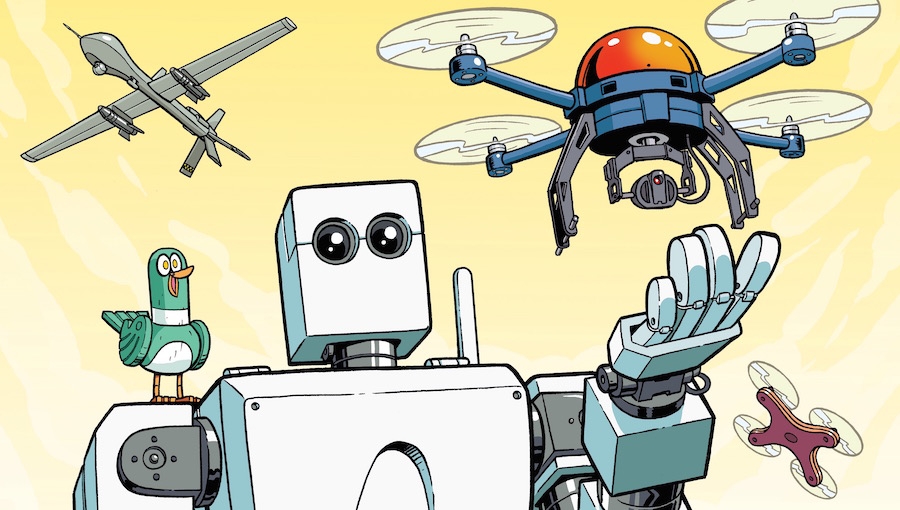The following is an interview with Mairghread Scott, writer of the upcoming graphic novel, Science Comics: Robots and Drones, to be released in March 2018 from First Second Books. In this interview, Fanbase Press Editor-in-Chief Barbra Dillon chats with Scott about the premise of the Science Comics series, the target audience and the lessons that they will take away from the book, the surprisingly early uses of robots in our society, and more!
Barbra Dillon, Fanbase Press Editor-in-Chief: Your new graphic novel, Science Comics: Robots and Drones, will be released in March 2018 from First Second Books. For those who may be unfamiliar, what can you share with us about the Science Comics series and your new installment focused on robots and drones?

Mairghread Scott: The Science Comics series is designed to give young readers a ton of information about specific scientific topics in a fun and exciting way. For example, in Robots and Drones, our story is told by a cute mechanical bird who we learn is one of the earliest forms of robots. They take us through the entire history of robots, teaching the readers about all the different forms robots have taken through the years and what they’re like today. This format is a great way to introduce kids to these various topics and get them to explore new ideas in a very entertaining way.
BD: What do you hope that readers will take away from the graphic novel, and would you say that there is an appropriate reading level for the book?
MS: This book is aimed at ages 9 to 13 and should really help sate the curiosity of those tweens who just have to know everything about robots. I really hope that kids learn that robots are much more normal than we think. You probably have a few robots in your home right now. Of course, there are also some pretty amazing robots and drones out there, too, and I want that part of the book to inspire readers to maybe join an after-school program, take a class in robotics, or build their own robots.
BD: In researching the history of robots, was there anything that you learned that may have been surprising regarding the evolution of the technology?
MS: I think we often think of robots as a very modern invention, but my research showed that there were very early examples of robots used in many different ways all the way back to Ancient Greece. Robots have been around for a while, and we are constantly finding new and exciting uses for them. I think readers will really enjoy looking into the history of robots, as well as looking at some of the modern advancements.
BD: What can you tell us about your work with artist Jacob Chabot, and how would you describe your shared creative process?
MS: I threw tons of reference at Jacob for all sorts of different robots, and he somehow not only was able to very accurately depict everything but also make the robots very cute and fun. They just have a ton of personality! I especially love the way he brought our narrator, Pouli, to life. Jacob’s character designs and energy really make our subjects jump off the page.
BD: What makes First Second Books the perfect publisher for Science Comics: Robots and Drones?
MS: First Second really knows how to use the comics medium to entertain and educate readers from elementary school into adulthood. There’s no one better suited to help us get this information into the hands of as many readers, libraries, and schools as possible, and I am very excited to work with them.
BD: Are there any upcoming projects on which you are currently working that you would like to share with our readers?
MS: Well, a month after Robots and Drones comes out, my original graphic novel, The City on the Other Side, will be released (on April 24th, 2018, I believe). This is an original story I co-created with artist Robin Robinson that follows a young girl named Isabel who gets caught in the middle of a war between two groups of fairies. Isabel and her friends must travel through the city of San Francisco on both the human and fairy sides of the veil to deliver a powerful artifact and end the war. It is a beautiful book that will delight eight to twelve-year-olds looking for magical adventure.
BD: Lastly, what is the best way for our readers to find more information about Science Comics: Robots and Drones and your other work?
MS: Well, be sure to follow First Second Books on Twitter, tumblr, and Facebook for all kinds of updates on everything related to the Science Comics series. You can also follow me on Twitter at @MairghreadScott or check my website, www.MScottWriter.com, to learn more about my work in comics and animation and for funny anecdotes about raising a very adventurous toddler.

